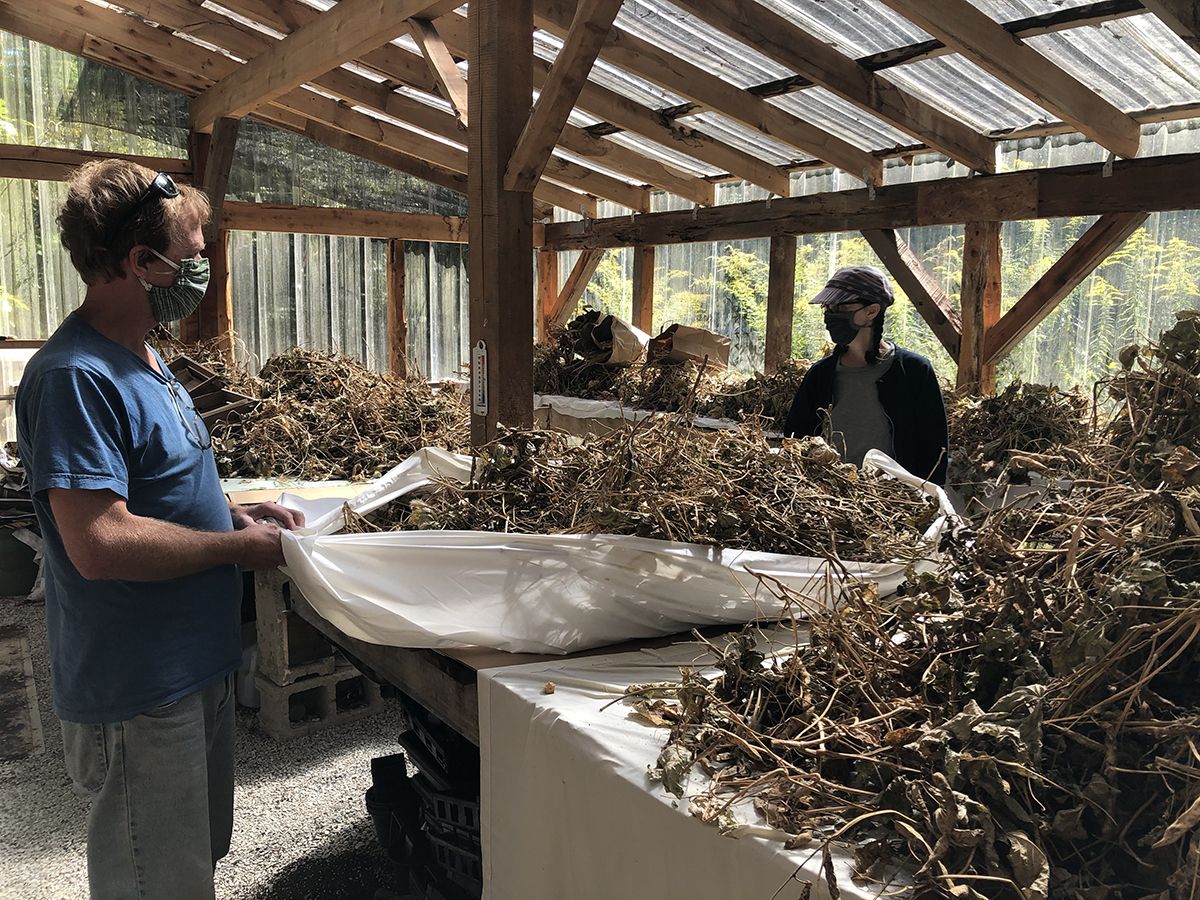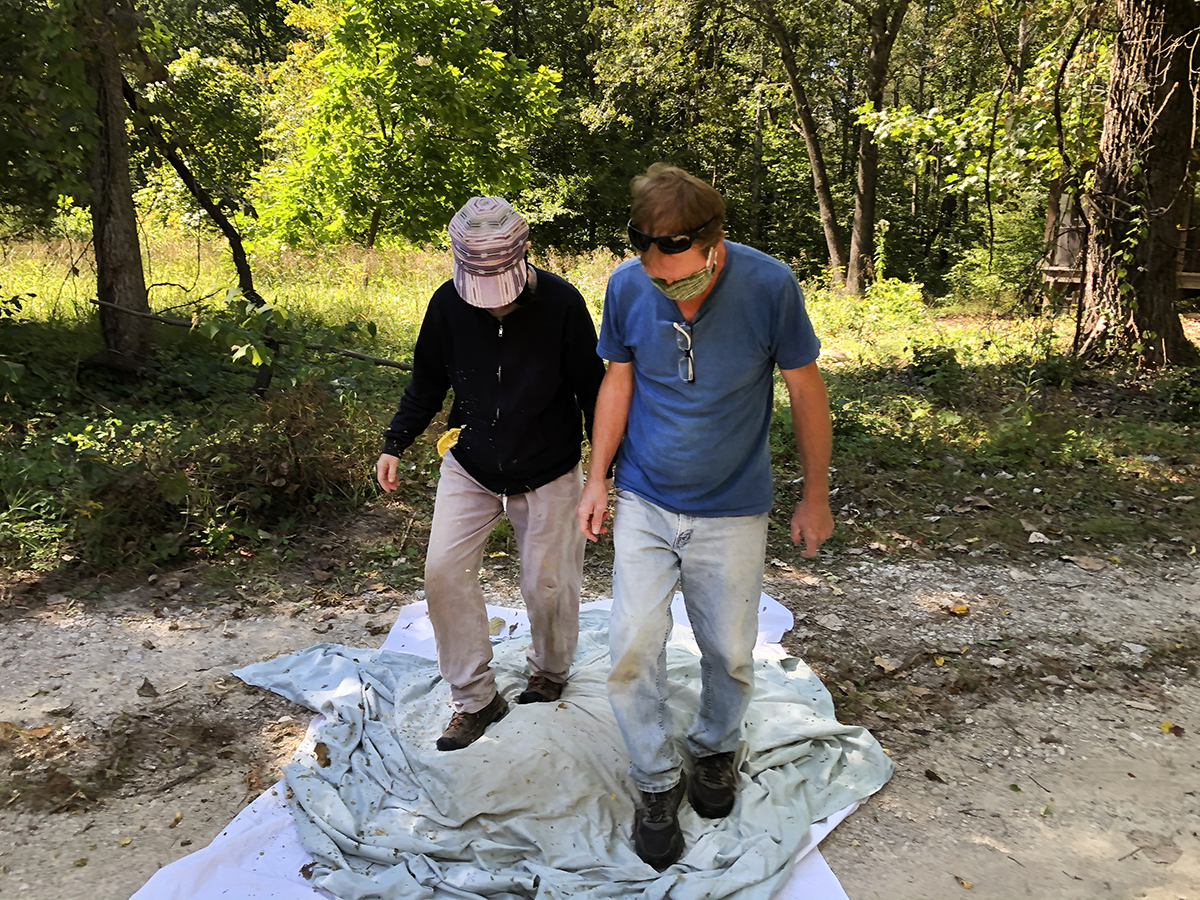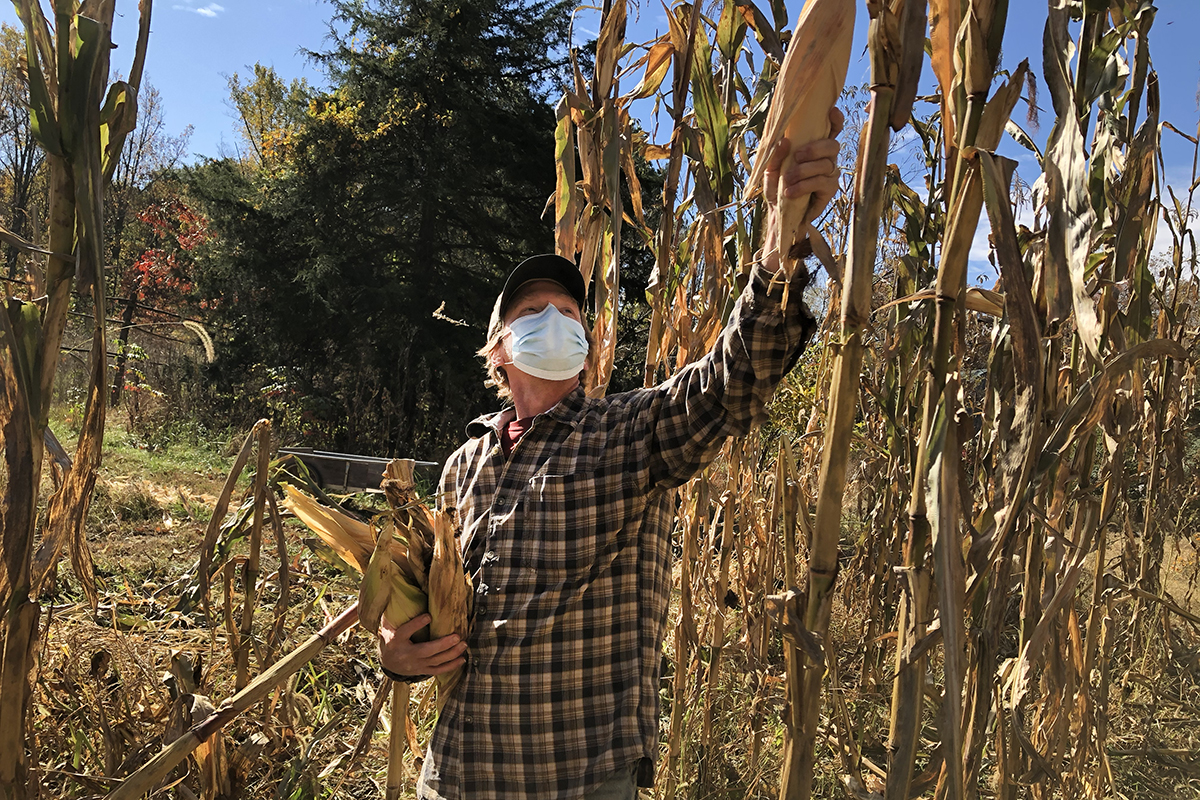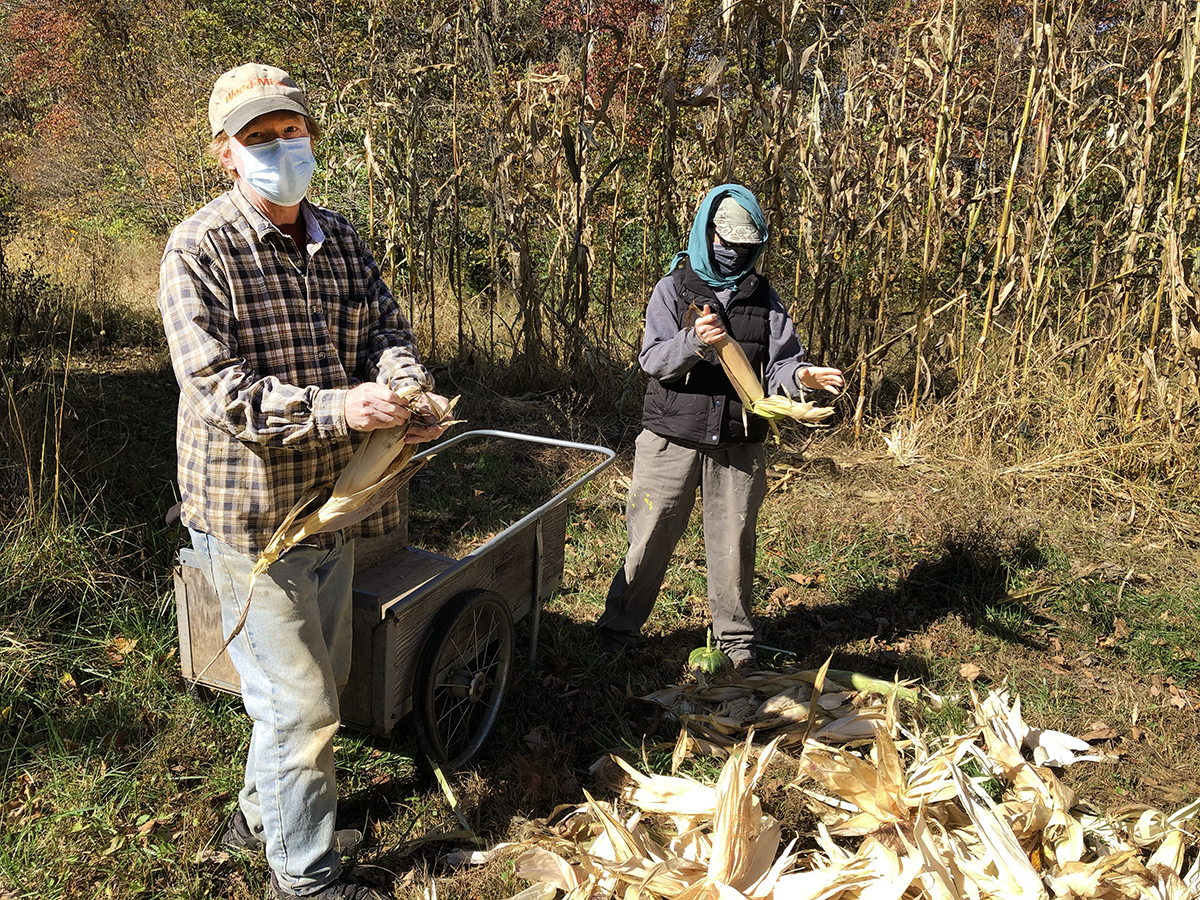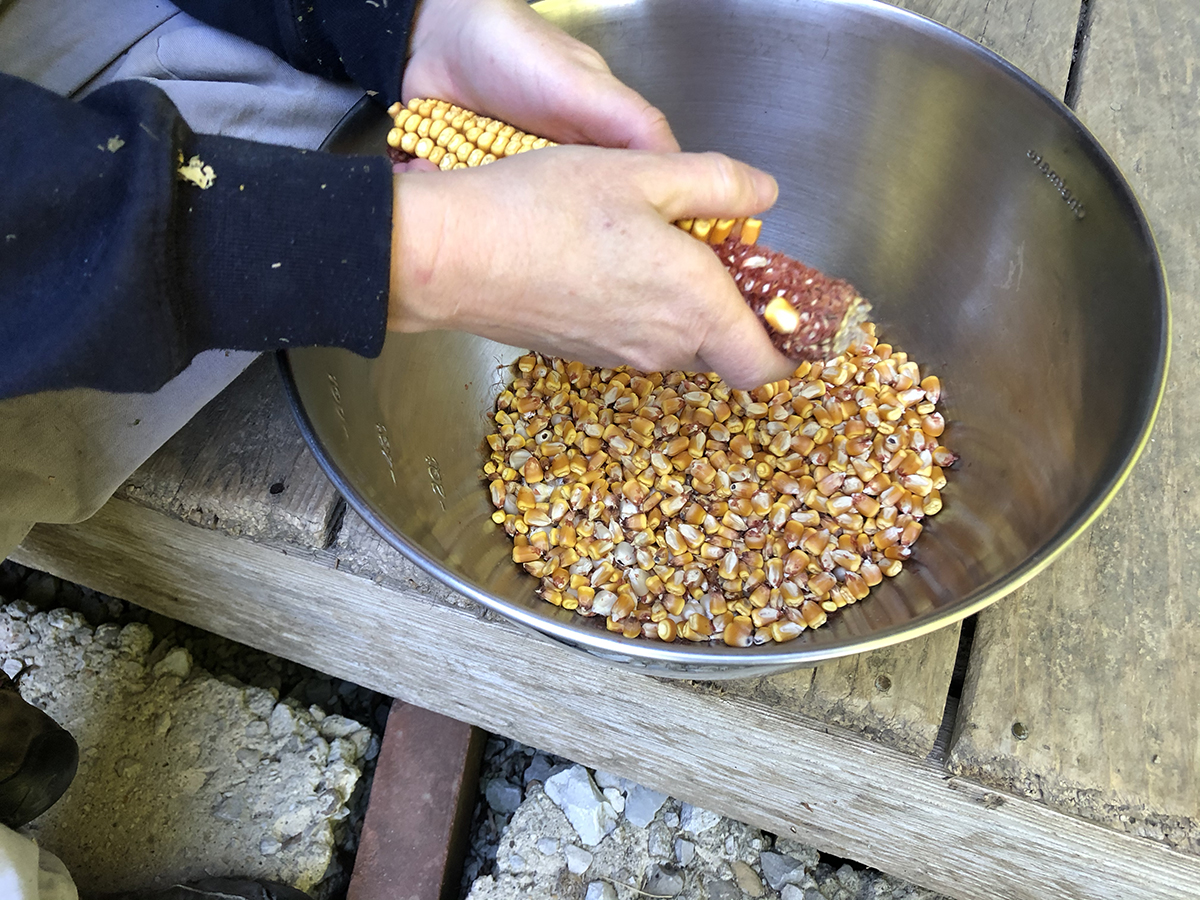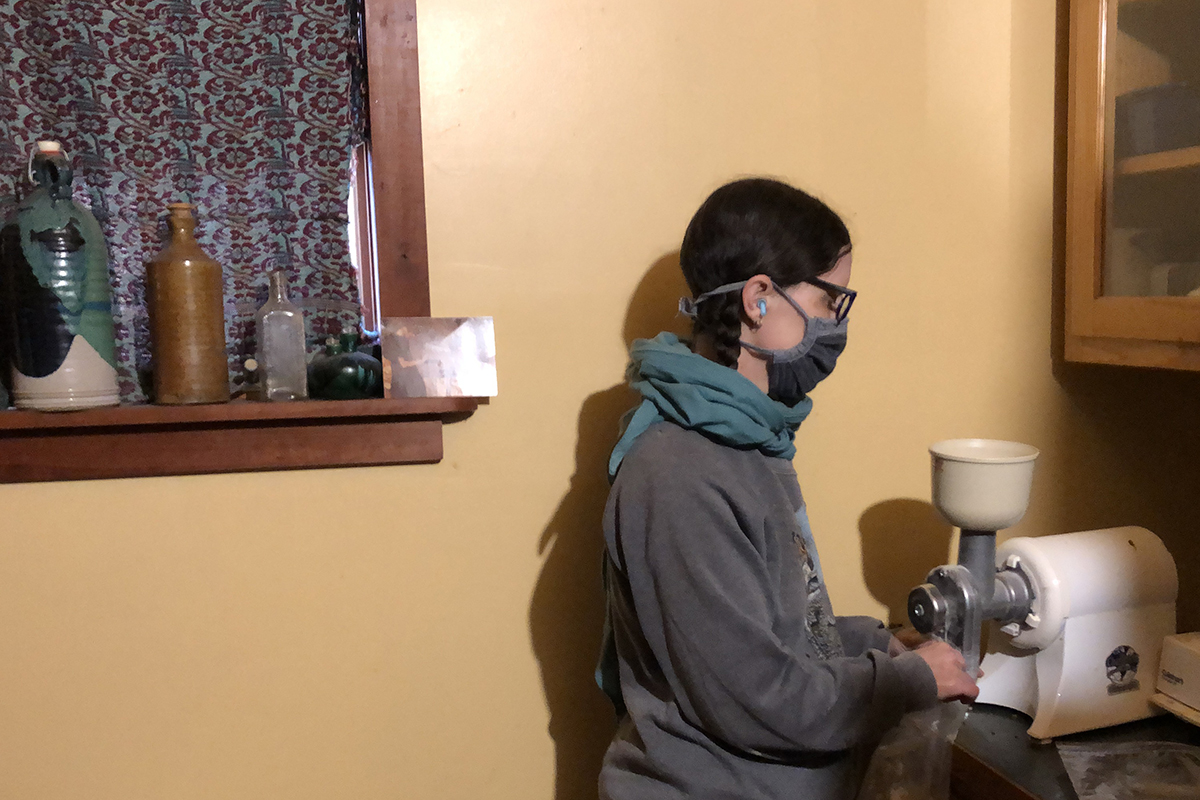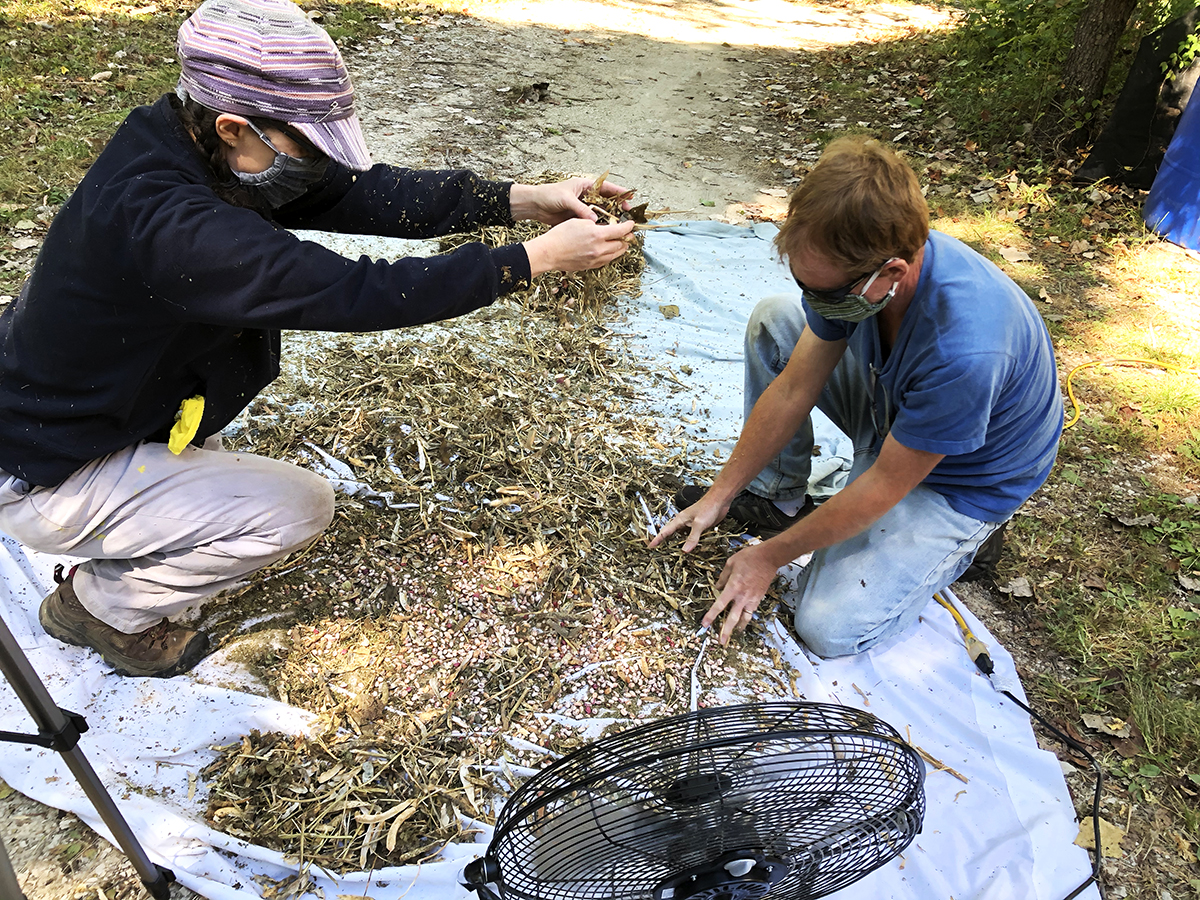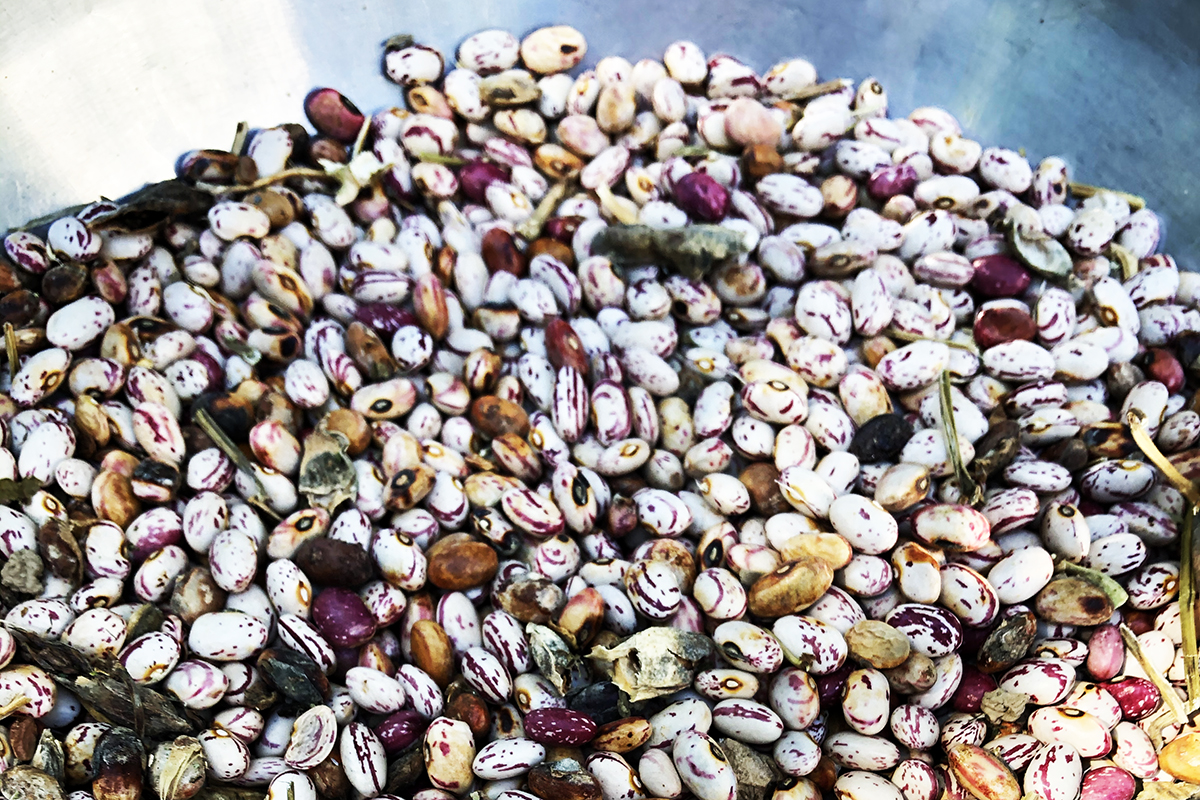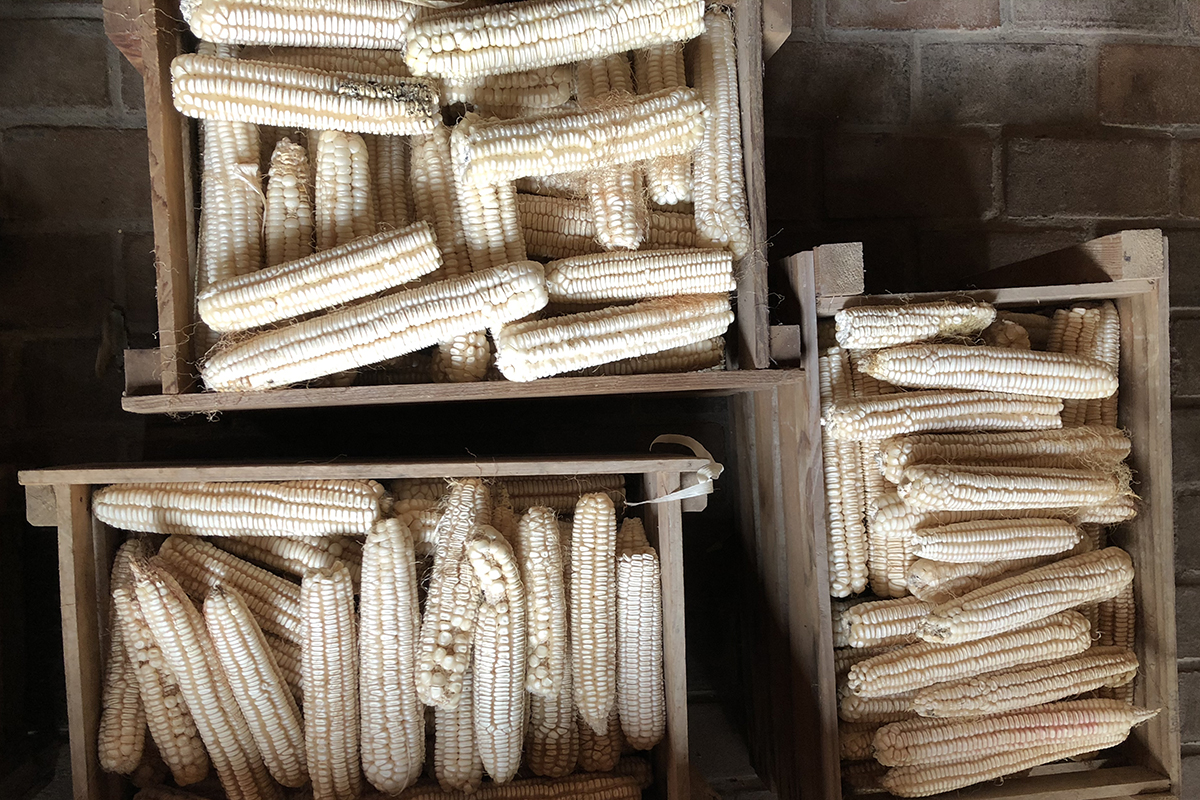KAYTE YOUNG: From WFIU in Bloomington, Indiana, I am Kayte Young and this is Earth Eats.
DENISE BREEDON-OST: There's a feeling to it that's kind of satisfying in that way. It doesn't feel like so much we could survive on as we're able to provide some of our sort of staple foods.
KAYTE YOUNG: On today's show, we're continuing to celebrate our 15th anniversary with a favorite story from 2020 about my visit to a farm, east of Bloomington, Indiana to speak with Denise and Shaun Breedon-Ost. We talk about growing food, preserving food and eating food. We check out their dried bean threshing techniques and reflect on the notion of food self sufficiency, plus food news from Harvest Public Media. That's all just ahead, so stay with us. Thanks for listening to Earth Eats, I'm Kayte Young. Let's start with food news from Harvest Public Media.
KAYTE YOUNG: Fruits and vegetables grown on urban farms and gardens have a carbon footprint that's six times larger than conventionally grown produce, that's according to a study out last week from the University of Michigan. Harvest Public Media's Elizabeth Rembert reports.
ELIZABETH REMBERT: It's the infrastructure that increases urban farms carbon footprints. It takes a lot of carbon to build the raised beds, compost bins and sheds that a city garden needs. Meanwhile, conventional farms are massive economies of scale and deficiency but Jason Hawes, a lead author on the study, says conventional produce loses to urban crops when it travels by air.
JASON HAWES: Asparagus is the one that we highlight as a case where things are flown in from, for example, Chile. That's a really big carbon investment that you could offset by using urban agriculture.
ELIZABETH REMBERT: The study also suggest city farms preserve their infrastructure as long as possible and try to use recycled materials to build their raised beds and sheds. I'm Elizabeth Rembert, Harvest Public Media.
KAYTE YOUNG: Three states recently moved to ban the calorie pear tree, commonly called the Bradford Pear. Now Missouri's legislator and the Kansas Department of Agriculture are considering bans on selling the invasive ornamental trees. Celia Llopis-Jepson reports for Harvest Public Media.
CELIA LLOPIS-JEPSON: The Kansas Department of Agriculture wants to ban calorie pear trees, also called Bradford pears and many other names. It will hold a hearing on the issue later this month. These trees are popular for their white flowers but they're escaping suburbia and invading prairies and woods, squeezing out native plants that support the food web. Under the proposed ban, homeowners wouldn't be required to cut down existing trees but some conservation groups and local governments give free native trees to people who cut down calorie pears on their property. For Harvest Public Media, I'm Celia Llopis-Jepson.
KAYTE YOUNG: At least 21 states are considering legislation to block foreign companies and individuals from purchasing farmland, that includes Illinois, Michigan and Indiana. Harvest Public Media's Kate Grumke reports.
KATE GRUMKE: Many of the proposals state law makers will consider target countries that are considered foreign adversaries like China. But Chinese companies own a relatively small amount of US agricultural land says David Ortega, a food economist at Michigan State University.
DAVID ORTEGA: We're looking at countries like Luxembourg, Portugal, entities from those countries own significantly more land than entities from China.
KATE GRUMKE: Canadian individuals and companies are actually the largest foreign agricultural land owners according to the US Department of Agriculture. Much of that is forest land for timber. For Harvest Public Media, I'm Kate Grumke.
KAYTE YOUNG: Harvest Public Media is a collaboration of public media newsrooms in the Midwest and Great Plains. Find more at harvestpublicmedia.org.
KAYTE YOUNG: Picture beans growing on a plant. They're in a pod, a long green somewhat skinny pod. Now picture them dried. The pod has turned a pale beige color, it's papery and the bean inside has hardened and dried. Now the beans are ready to thresh. In a greenhouse attached to a barn, at Shaun and Denise Breeden-Ost's barn, wooden tables are lined with white sheets and piled with dried bean plants ready to be thrashed. Working together, they each gather two corners of one of the sheets and pull a mass of dried bean plants out of the greenhouse and onto the gravel driveway. They cover the dried plants with a second sheet and then they walk on them.
KAYTE YOUNG: They aren't particularly gentle about it. Apparently the beans are pretty tough. The point is to loosen the dry beans from their pods. They stop periodically to check on the progress and refold the sheet and then they walk on them some more.
DENISE BREEDON-OST: Kind of fold it over on itself and then do some more. When we harvest them, there's a real prick of timing that you're kind of splitting the difference; you want them to be dry enough that they won't mold before they get crispy and dry but you also want them to be not so dry that they shatter out of the pods when you're picking them in the field. So, that takes some guess work every year. I'm taking the chaff, the broken up vines and pods and everything and lifting them off of the beans that are down on the sheet, kind of shaking out any loose beans that are hiding in there, so we end up with just beans and little lightweight stuff left on the sheet, like the small pieces and then we're going to winnow that with a fan.
DENISE BREEDON-OST: And this is all basically made up. This isn't like the way that you do this. This is just the way that it seems to work for us. A lot of people thresh their beans by hitting them with sticks or like the traditional foil which is a tool that you use to thresh things. It's like two sticks with a chain holding them together so you can get more force with your swing, because you've got that momentum on the moving piece. But, for me, walking on things is just like easier than waving my arms around. I mean people used to thresh grain. They would have a really tight floor somewhere in their barn or their house and they would have a threshold at the door that keeps the grain from spilling out, so they'd throw it all in there and then they'd thresh it and flail at it until it all came out and then it would all be held in that floor. But we didn't want to do it in our house and we don't really want this much dust even in the barn.
DENISE BREEDON-OST: So, we use sheets for a lot of things, old sheets or something that we kind of inherited some of with this house, there were sheets that didn't fit any of our beds. So, sheets have been a good farm tool. They're good to harvest the beans into and carry them. They're just kind of our tarps.
KAYTE YOUNG: Once they're satisfied that most of the beans are out of the pod, it's time for winnowing.
DENISE BREEDON-OST: I think the thing I find really satisfying about this particular job is that it's like you're using your bodyweight and gravity and wind. You know, it's just so like the most basic technology.
KATE GRUMKE: What are these called again?
DENISE BREEDON-OST: This is called tailor dwarf horticultural and it's sort of like a pinto cranberry kind of bean, striped. We usually cook these into, well when I was a kid we just called beans in cornbread, beans cooked with onions and celery and peppers and things and then served with cornbread is kind of a classic way I like this kind of bean. But we grew a lot this year so we might find lots of new ways.
KATE GRUMKE: Eventually they transfer the beans to a wide metal bowl and place it close to the fan to winnow the final particles away.
DENISE BREEDON-OST: [INAUDIBLE] I would take them and then I'll just pick through them by hand, sort through them by hand before we have them in our jar to cook. So what I usually do then is I’ll spread these out like on a cookie sheet and just move the good ones to the side and move the other stuff to the other side.
KAYTE YOUNG: It's recommended to do that with store bought beans to look for stones and stuff.
DENISE BREEDON-OST: I wish I'd done it. Recently we bought some black beans and found a rock, I mean the size of a black bean, I bit down on it.
KAYTE YOUNG: Denise remembered a poem that she found in Madhur Jaffrey's World Vegetarian cookbook. It's something she thinks about when she's sorting beans, It makes her feel connected to women around the world.
DENISE BREEDON-OST: A lentil, a lentil, a lentil, a stone. A lentil, a lentil, a lentil, a stone. A green one, a black one, a green one, a black, a stone. A lentil, a lentil, a stone, a lentil, a lentil, a word. Suddenly a word, a lentil. A lentil, a word, a word next to another word, a sentence. A word, a word, a word, a nonsense speech. Then an old song, then an old dream. A life, another life, a hard life, a lentil, a life, an easy life, a hard life, why easy, why hard. Wives next to each other, a life, a word, a lentil. A green one, a black one, a green one, a black one, pain. A green song, a green lentil, a black one, a stone. A lentil, a stone, a stone, a lentil.
KAYTE YOUNG: Cleaning lentils was written by the Istanbul based Armenian poet, Zuhad. The poem was read by Denise Breedon-Ost. After a short break we'll sit down with Denise and Shaun Breedon-Ost to talk about growing staple foods and we'll wonder about what kind of apocalypse you might be preparing for. Stay with us.
KAYTE YOUNG: Kayte Young here, this is Earth Eats and for our 15th anniversary, we're looking back to some of our favorite stories. This story was recorded back in 2020, when a lot of people were taking up gardening, claiming they needed to become self-sufficient. I remember shaking my head at the notion of first time gardeners planning to survive the year on food from their veggie patch. Then later in the summer, I learned that a couple of growers with many years of experience had planted a decent amount of beans for drying and corn for cornmeal and I thought, well, they might be growing enough food to survive on. These particular farmers also grow and put up a lot of fresh produce from their garden, canning, freezing, drying, curing. So, perhaps, they could be eating their garden's bounty all year long.
KAYTE YOUNG: And then I started to think more about the complicated notion of self-sufficiency. I knew that these growers were thoughtful people. So I sat down for a conversation with Denise and Shaun Breedon-Ost, they were the ones you just heard threshing beans and reading poetry. We talked about growing enough food, growing too much food, the pleasure of working with plants and the tendency to personalize your apocalypse fantasies to suit your skill set. Denise and Shaun live on a hilly and somewhat forested patch of land, east of Bloomington, about a 20 minute drive from downtown. Shaun grew up on the property. He and Denise live up on the hill and Shaun's brother lives down in the valley.
KAYTE YOUNG: While the woods can be dense, there are plenty of large clearings for growing food. Shaun has been a market farmer for decades. Denise is a writer but she's also played an active role in the farm over the years. They no longer grow food for market but the growing of food has not stopped. I asked them to tell me about what they grow.
DENISE BREEDON-OST: A lot of greens, potatoes, peppers.
SHAUN BREEDON-OST: Potatoes.
DENISE BREEDON-OST: Sweet potatoes.
SHAUN BREEDON-OST: Corn.
DENISE BREEDON-OST: Summer and winter squash, turnips and rutabagas.
SHAUN BREEDON-OST: Beans.
DENISE BREEDON-OST: Onions, garlic.
SHAUN BREEDON-OST: Okra, hot peppers.
DENISE BREEDON-OST: Blueberries.
SHAUN BREEDON-OST: Cucumbers.
DENISE BREEDON-OST: We grow a lot of peaches but the squirrels eat those green. So, we don't actually eat those but we do grow them.
SHAUN BREEDON-OST: We have a lot of asparagus.
DENISE BREEDON-OST: Yeah, asparagus.
SHAUN BREEDON-OST: Shiitake mushrooms.
DENISE BREEDON-OST: That might be a pretty good summery...
SHAUN BREEDON-OST: Basil.
DENISE BREEDON-OST: ... summery basil.
KAYTE YOUNG: How do you determine what to grow?
SHAUN BREEDON-OST: Well it's based on what we like really.
DENISE BREEDON-OST: We kind of sit down with the sea catalogs in January and talk about what we want to grow and it's pretty consistent. I mean it's the foods that we like to eat and that we know we can grow here and then we try something new every once in a while. We've given up on some things that don't do well here or that we're just not very good at.
KAYTE YOUNG: Like what's an example of that?
SHAUN BREEDON-OST: Well pole beans. We love pole beans but putting up the trellis and we had a bean mosaic a few years ago and we pretty much decided to stop with the pole beans and just go with the bush beans.
KAYTE YOUNG: Was it a virus?
DENISE BREEDON-OST: Oh, it killed it. And if you have bush beans and something happens to them, you can just replant, you can till them and if the bean beetles are the disease or something gets bad and we'll plant another row. But with pole beans you're kind of invested for the whole season and so we went with the bush beans. We can't grow very good spinach up here and Shaun's brother down in the valley grows great spinach, so we just don't bother. We've never had great luck with beets but I think that was mostly just neglect. I'm not sure. So there are a few things that just haven't thrived.
DENISE BREEDON-OST: Our sweet potatoes we've experimented with over the years and some of them didn't do well here and some did. And so it's more of a variety choice. Tomatoes, for years, we had a two week tomato season because of disease pressure and we finally found a couple of varieties that we can grow and we had a full tomato season this year, we're so excited. It's like wow, there's still tomatoes out there. So a lot of it is choosing the varieties that like it here.
KAYTE YOUNG: And so when you're growing, are you also thinking about, or when you're picking your seeds or deciding what to grow, are you also thinking about food preservation?
DENISE BREEDON-OST: Yeah. We definitely grow to put up, I mean that's part of, at least with a lot of our crops, that's part of what we're doing and I have records of how much food we've put up in the past for the past, I don't know, 10 years or so that I've been doing that. And so I can look back and say okay, last year I put up this much and we did or didn't eat it all and how did that go. And so this year I want this much instead. And so we've kind of tweaked the amounts over time for what seems to work for us. It made a huge difference because I was starting pretty much -- I mean food preserving -- I had an aunt who did a lot of it but it's not something that my parents did and not something I learned to do when I was at home. So as an adult I was learning how to do that and so I took a lot of notes.
DENISE BREEDON-OST: I was like here's what I put up, here's how I did it and here's how it turned out and here's when we ran out of it and it let me feel like I was learning rather than just starting again every year.
KAYTE YOUNG: Yeah, also I could see where having an understanding of did we use this, like we froze all this broccoli but we didn't like how it tasted so we never used it and then it's got freezer burn and sat there in the freezer all year.
SHAUN BREEDON-OST: That's one of them.
DENISE BREEDON-OST: And I hate wasting food and so yeah it was really important to me to not -- and it's not just wasting food because I mean if we don't put up all of our tomatoes and some of them rot, we just throw them in the compost and then they go back to the soil and whatever, but if I've put in hours and hours of labor and propane, and [LAUGHS] jars and lids and all of that, then it feels like a bigger waste. So, yeah, I want to make sure that we eat everything I put up as much as possible. So, yeah, I do write it down.
SHAUN BREEDON-OST: And things like potatoes, we know how many pounds we'll eat before they sprout and so when we harvest, we see how much we have and then we keep what we're going to use and then we give the rest away, so.
DENISE BREEDON-OST: We usually keep more than we'll use and then right before they start to sprout we call up our friends and we say, "can you eat a bunch of potatoes in the next two weeks?" And they're like, "sure" and share around then.
SHAUN BREEDON-OST: Yeah, we're getting better at it.
DENISE BREEDON-OST: Yeah.
KAYTE YOUNG: Do you have an idea about you want to eat mostly the produce that you grow yourselves throughout the year or is it just kind of seeing what you can do? I don't know if you want to talk a little bit about some of the values or goals that you have that are associated with that.
SHAUN BREEDON-OST: I think over time we've just kind of learned to like the stuff that we grow and we don't really desire other things that we can't grow like things that are out of season and we're happy with collards. We don't have to have lettuce if we don't have it. So it's not really that our goal is to provide all of our food, we just know how much we need to grow and we grow what we know we can and we enjoy what we grow.
DENISE BREEDON-OST: My friend Stacy said one time that something like if you want to produce your own food it's better to start instead of growing everything you want to eat, you should start with eating everything you can grow and that's really, we're not real recipe users. I mean we use recipes for inspiration but we really start with the food we have which helps a lot because if you look at a recipe, every recipe is going to call for like a scallion or something and scallions are not something we have in January. But, yeah, I mean we buy produce, we buy avocados.
SHAUN BREEDON-OST: Yeah we do.
DENISE BREEDON-OST: We buy a little bit of fruit and odds and ends and after we run out of potatoes, we'll buy some potatoes and I buy okra at the farmer's market every year because I'm not very good at keeping okra picked and so we grow it but it doesn't really work and I only want one batch of it anyway. So, I just buy that. But there was a while when Glen was little, there were probably five years or more where we grew and preserved all the produce we ate except for a little bit of fruit. I'm not sure why. Like that was in my mind was that was what I wanted to do and some of it may have just been finding out if it was possible, finding out if I could. But yeah, we pretty much ate only the vegetables we grew for quite a few years and then Glen got older and he was like, "I want a salad" and so we got flexible.
SHAUN BREEDON-OST: Or "I want mangoes".
DENISE BREEDON-OST: Yeah, he wanted mangoes.
SHAUN BREEDON-OST: "I'm sick of blueberries".
DENISE BREEDON-OST: So that part of it, it changed as our family changed.
KAYTE YOUNG: And then there are things like olive oil and maybe flour and stuff that you're not going to be growing so you're going to be purchasing those things.
DENISE BREEDON-OST: Yes.
SHAUN BREEDON-OST: Yeah. I mean sugar and salt, flour, oils.
DENISE BREEDON-OST: Lots of different beans and grains and nuts and seeds. We buy a lot of food.
SHAUN BREEDON-OST: Yeah.
DENISE BREEDON-OST: But we don't buy a lot of fresh produce. Most of our fresh produce is something that we have and much of our season produce too is something that we grew.
KAYTE YOUNG: So what kinds of things do you put up when you do food preservation? What are some examples?
DENISE BREEDON-OST: Frozen peppers, dried peppers, paprika, tomato juice, relish, jam and dry beans and corn, frozen green beans.
SHAUN BREEDON-OST: Frozen greens.
DENISE BREEDON-OST: Frozen greens, frozen pastille. We just made candy ginger for the first time, that was kind of cool.
SHAUN BREEDON-OST: From market ginger.
DENISE BREEDON-OST: Yeah local.
SHAUN BREEDON-OST: Fresh ginger.
DENISE BREEDON-OST: That was cool.
SHAUN BREEDON-OST: It's very good.
DAVID ORTEGA: Potatoes and winter squash and sweet potatoes which you don't have to do anything to, you just have to give them the right conditions to not rot. What else do we put up? It seems like, I don't have my notebook. Lots of frozen blueberries.
KAYTE YOUNG: You grow enough blueberries that you can put them up for a whole winter?
DENISE BREEDON-OST: Oh; yeah. In 2019 we put up like 40 gallons frozen. We eat those -- and pancakes were things but I also make blueberry jam sort of continuously through the whole year and that's the jam that we like. So we eat it for breakfast every day.
SHAUN BREEDON-OST: And our famous blueberry smoothie.
DENISE BREEDON-OST: Yeah the blueberry smoothies in the summer.
SHAUN BREEDON-OST: Sunflower seeds and blueberries and a little bit of honey, some water, it's breakfast.
KAYTE YOUNG: I mean you said something earlier Shaun about kind of adjusting your tastes and your desires to what you have and accepting. Like you said, Glen was like, "I'm tired of blueberries".
SHAUN BREEDON-OST: Yeah. And I think that's evolved over the years. I guess I've always liked garden produce.
DENISE BREEDON-OST: I've learned to like quite a few things over the years. Shaun has never been a picky eater but I didn't really love Brassica family and greens and arugula grossed me out, and I hated cilantro, and I didn't like melons, and I didn't like cucumbers and gradually over the years, I've actually come to like some of those which in some cases it was really exciting because I always wanted to like melons, I just didn't and in others it was like arugula, still if I didn't have arugula ever again, I wouldn't cry but if it happens to be the green we have and I want some greens to go in something, I'll use it and be happy with it. So there's a, I don't know, it's kind of I'm a little more flexible than I was.
DENISE BREEDON-OST: I mean we had some conversation when Glen was 14 or 15 or so about like "why do we have these juicy tomatoes that make a mess when I eat them on my sandwich? We should go to the store and buy a proper sandwich tomato that...
SHAUN BREEDON-OST: "Is dry and crunchy".
DENISE BREEDON-OST: ...that doesn't turn into slop." So, it was interesting to actually hear him working through that and coming up with his own opinions because it never would occur to me to buy different kind of tomatoes. Like well we've got these tomatoes but I can see how, you know. It's possible to have some other way of working with produce but we've gotten used to this. Is kind of what we do.
KAYTE YOUNG: Yeah, I've always been resistant to a CSA because I was afraid I would waste the food, that I just would like the idea of it but I wouldn't actually eat it because that's just not the way I cook. But if I was a farmer, I think I would adjust the way I cook.
DENISE BREEDON-OST: You probably would have to.
SHAUN BREEDON-OST: Well, you can adapt recipes to what you have too.
KAYTE YOUNG: True to a certain extent. Again, that's where the flexibility comes in. I think it's a mental [UNSURE OF WORD].
SHAUN BREEDON-OST: And I think that's what we do, is we just adapt it and we're like hm, collards are just as good as spinach, so.
DENISE BREEDON-OST: And sometimes we buy a package of frozen spinach.
SHAUN BREEDON-OST: Sometimes we do.
DENISE BREEDON-OST: Because spinach and feta pastry thingy sound really good and I want to make some for my son and he likes spinach better, and so I just buy some. When I was a kid, I mean I learned to cook from my mom as a teenager and she is somebody who, she goes to the store to replenish her supply of the things that she always has on hand and then she makes the food that she makes with that food and it's really good food and it varies quite a bit and it does include garden stuff. But I didn't grow up buying vegetables at the store like zucchinis or peppers or things like that. We bought potatoes and onions and carrots at the store.
DENISE BREEDON-OST: And it wasn't like we couldn't buy anything else but it was just like there was a standard range of stuff we always had on hand and that's how I learned to cook.
KAYTE YOUNG: Yeah.
DENISE BREEDON-OST: And I think that helps me be adaptable. Oh about the CSA thing, one thing that made me think I was home. We had a CSA, we ran a CSA. Sometimes people wouldn't pick up a share and we would bring it home and put the produce in the fridge and sometimes the produce went bad. So I just want to say to people who are CSA customers, you're not a terrible sinner or maybe I'm a terrible sinner too. But it was actually harder to use up a box of CSA produce because it had already been harvested and when you have it in your garden you can decide well I'm not using those onions today and they'll keep for three weeks, they'll sit there in the ground. They'll just get bigger.
DENISE BREEDON-OST: And so I think it's actually a little more flexible when the stuff is actually out in the garden on plants and you pick it when you need it. So in some ways we do go to the store when we decide what we're making. It's just the store is the garden.
KAYTE YOUNG: I'm speaking with Denise and Shaun Breeden-Ost about growing food, preserving food and eating food. After a short break, we'll talk about what it takes to grow your own dry goods like beans and grains and about prepping for the apocalypse or not. I'm Kayte Young, this is Earth Eats, stay with us.
KAYTE YOUNG: Kayte Young here, this is Earth Eats. I had the chance to visit with Shaun and Denise during the corn harvest season. They walked me through the steps of getting dry seed corn from the field to the table. A variety of corn they raise grows incredibly high, it towers over our heads.
SHAUN BREEDON-OST: When going in, we start yanking them down.
KAYTE YOUNG: So you're yanking the ears, not the stalk?
DENISE BREEDON-OST: Yeah, and as you can see there's a height issue here.
SHAUN BREEDON-OST: Because you grab the husks and peel them back. Peel them back. Snap it off, make sure it's the sound ear.
DENISE BREEDON-OST: This is Hickory Cane corn. It's a white heirloom corn. I was pretty suspicious about white corn at first because I really like my cornbread to be yellow, but this stuff tastes amazing.
SHAUN BREEDON-OST: So yeah what we'll do is we shuck it and then we'll stack them loosely in crates and take them inside and let them dry for a good month or two before we grind it and we still have lots of corn left from last year and the year before. So, kind of have 520 foot rows and then another hundred foot row. It is more than we usually grow. I was worried about what we were going to do with all the corn but the squirrels kind of solved that problem for us. So, I think we'll end up with about eight bushels or so. It's enough to eat, share, lots of polenta, cornbread. It's a tremendous amount of calories that are on each plant and it's well adapted to our environment.
DENISE BREEDON-OST: This last revision on my novel. When I was writing about shucking corn and I was trying to describe the breaking off of the bottom part of it, I actually called my mom and then called my granny to find out if there is a name for that part you break off. Like do they have a name for that and they're like, "no, it's just the part you break off". I said, "cor, that's not very elegant". So I think I ended up calling it the stem which is what it is but I felt like there should be a name for that gesture of breaking the bottom and all the shucks off of the corn. It's such a common thing people have to do. But I guess they didn't feel like they had to talk about it.
KAYTE YOUNG: The next step was shelling.
DENISE BREEDON-OST: I used to do this when I was kid. We used to go into neighbor's cornfield with feed corn and pick corn and shell it off and use it for corn bites.
KAYTE YOUNG: So what's involved in a corn fight?
DENISE BREEDON-OST: You have a bunch of corn that's shelled off the ear and store it in margarine tubs or something, and you have [INAUDIBLE] out of things and you rush out at each other and fling handfuls of corn at each other.
KAYTE YOUNG: So there's no device. It's just your hands.
DENISE BREEDON-OST: Yeah. It's just throwing corn at each other.
KAYTE YOUNG: And then they bring it inside to grind it. They have a grain mill attachment for their champion juicer, it's one of those classic juicers with a heavy duty motor.
DENISE BREEDON-OST: And you grind it twice because you have to crack it first.
KAYTE YOUNG: After a second pass with the grinder, they set the cornmeal through a mesh sieve and it's ready to use for polenta or grits or cornbread. For this coarsely ground cornmeal, Denise uses a hot water cornbread recipe which you can find at eartheats.org. We tried it this week and I highly recommend it. When I first heard that Shaun and Denise were growing their own beans and grains I wanted to hear more about their motivations. Shaun said he tried sea corn for the first time a few years ago. He remembered a variety that has grandfather had given them when he was a kid. He looked for something similar and gave it a try.
SHAUN BREEDON-OST: I just wanted to try it, so we put out a plot probably 30 feet wide by 40 feet and it grew just amazingly well.
KAYTE YOUNG: Once they had the corn there was the problem of grinding it.
SHAUN BREEDON-OST: We did some in our blender and figured out that was going to be the death of our blender. But then we acquired an attachment for the juicer that we have and boy it was amazing. Much sweeter and more corn flavor than store bought cornmeal. And so then I was hooked and we tried a different corn the next year and this year we planted about three times what we've ever planted before.
KAYTE YOUNG: And so was this the first time you had ever grown your own grain?
SHAUN BREEDON-OST: Yeah. And we've been growing dry beans since, at least 2010, maybe a little before that.
KAYTE YOUNG: And did you grow more of those this year as well?
DENISE BREEDON-OST: We didn't plant more but they thrived better.
KAYTE YOUNG: And so do you think of the corn and beans differently? I'm asking because I do. I see it as like, oh, that's moving towards self-sufficiency because if you can grow your own protein and you're not raising animals, it just makes me think of a more self-sufficient model that you could survive on that or something.
DENISE BREEDON-OST: There's a feeling too, it's kind of satisfying that way. It doesn't feel like so much we could survive on it as we're able to provide some of our sort of staple foods which, I mean, the potatoes and the sweet potatoes are staples, if anything is. But it breaks down a barrier in my mind between sort of dry goods and produce and mix it. Well actually, there's not a line there that says you can't cross it as a home gardener. I mean assumed that to grow your own corn you had to have -- I mean like for cornmeal you had to have acres and acres of corn, it just seemed like it would be this huge endeavor and it's not. I was really surprised by how much cornmeal there is from an ear of corn.
DENISE BREEDON-OST: And the beans I didn't have as much of a sense of that being different because when I was a kid my aunts grew horticultural beans and my grandparents have grown beans as well.
SHAUN BREEDON-OST: And I think a good part of it is that it's like the tomatoes and peppers, we just prefer the taste of these beans and this cornmeal over what we can buy.
DENISE BREEDON-OST: We do buy a lot of grains and beans because we want to have red split lentils and we want to have black eyed peas and we want green split peas and lentils.
SHAUN BREEDON-OST: And black beans.
DENISE BREEDON-OST: And brown rice and lots of things that we appreciate the variety of. So we're not at all trying to replace all of that but it's kind of nice to know that we can grow that stuff too.
KAYTE YOUNG: And when you've grown the corn, has it lasted you through the year?
SHAUN BREEDON-OST: Oh, yeah.
DENISE BREEDON-OST: Yeah, more than through the year.
KAYTE YOUNG: And then this year you grew more than you needed.
SHAUN BREEDON-OST: We did.
DENISE BREEDON-OST: Yeah. That was Shaun's decision making process. It's not mathematical.
SHAUN BREEDON-OST: Well I've always been one to plant way more than we need because I love giving away stuff and I just like how generous the land is with its abundance and this year the squirrels got more corn than we did. We shared quite a bit.
DENISE BREEDON-OST: They had a rough year.
SHAUN BREEDON-OST: They did.
KAYTE YOUNG: They did.
SHAUN BREEDON-OST: They didn't have any nuts and so they got fat on corn this year.
DENISE BREEDON-OST: Yeah, Shaun would be standing there by the kitchen sink and look out the window and he's like, "they're just running up the stalks. They're just running up the stalks and eating the corn".
SHAUN BREEDON-OST: There can be like five squirrels out there and like kernels flying everywhere. And then the birds come in.
DENISE BREEDON-OST: But still we've got more than we can possibly eat. Well, we've got more than we will eat.
KAYTE YOUNG: And if you can store it from year to year, like do you feel like it's stable enough that it's fine, the two year old corn is fine?
SHAUN BREEDON-OST: Oh, yeah.
DENISE BREEDON-OST: Oh yeah, we're still eating the older corn. It keeps really well. We keep it whole on the ear partly because it keeps better that way and then when we want some we shell it off the ear into a bowl and pour it through the grinder. Grind it through twice and then sift it and then usually I make enough for maybe a quart and a half of cornmeal at a time and I'll only use a cup to two cups when I'm making cornbread. So I put the rest in the freezer and use that as we want to so that it gets ground close to when it's used.
KAYTE YOUNG: Oh, I guess I want to get back to my other question about the idea of self-sufficiency or survival. I feel like it's come up a lot this year, pretty much as soon as the pandemic hit and grocery stores had less on the shelves than normal and people were at home more than normal, some, not all but some, that all of a sudden I started hearing, at least in the media circles, that I'm paying attention to which, granted, is limited and food focused, you know, there was just a lot of talk about, we gotta grow our own food, and I'm planting a raised bed this year because it's time to sustain ourselves, and having grown some food myself for the past 15 years, I was like, "okay, do you have any idea what you're talking about?" Just because one, it's not that easy, even if you do know what you're doing.
KAYTE YOUNG: And two, I just feel very suspicious of that kind of thinking of like, you know, we have a lot of canned goods stored in our basement that we've put away, and sometimes when people see it, they're like, 'oh, I'm coming to your house if there's a crisis or something' and I'm like, 'okay, fine' because that's what's going to happen is it's all going to be shared and be gone in like two days because what are you going to do if you got everything you need. Like how are you going to defend that. I don't know. There's just a lot of things that come up for me and I wanted to know if you guys had thought through any of those kinds of things when you start to think about self-sufficiency or survival or prepping or any of those terms.
DENISE BREEDON-OST: Every year we go into the winter time and like 'well, if it snows so much that we're snowed in for three months, we won't starve because we've got 100 squash on the shelf above the cabinet. So things like 'we might turn orange'. So yeah we have that feeling, it's not the primary motivation. It's one of the bi-products I think. A lot of it's curiosity. It's like I wonder if we could grow beans. I wonder if we could grow corn. Shaun planted rice this year and it was like I wonder if we could grow rice, I'm going to try it, and we had a little bit of rice and maybe we'll grow a little bit more rice in the future.
DENISE BREEDON-OST: And so it's more like, it adds to a bank of knowledge or to a sense of knowing and understanding and learning that's kind of an end in itself and it's a relationship in itself with this place and the land and the plants and in this sort of thing about like someday when everything falls apart, we're going to need this knowledge. It's like, 'well yeah'. I mean that's quite possible that we might need that knowledge first for that sort of reason but it's not the motivation. It's an after effect. That sense of competence in the world it feels good more than it is rational, I think. What I've noticed is that most people they pick which thing they want to not be able to get any more after the apocalypse. Like for me I'll be sitting around daydreaming about apocalypse which is something that I've done and think well, I know how to live without electricity and I know how to build a compost in toilet.
DENISE BREEDON-OST: So for me I can imagine being very satisfied and smug in oppose to apocalyptic future in which we don't have electricity and everybody else is in hysterics because they don't have a TV and I'm fine. But that's nonsense. I mean for one thing here we are in the middle of a pandemic and we had this sort of crisis in our society and what I ended up needing to do was not how to live without electricity but how to meet with people on Zoom which I was much less well prepared for.
So, in the sort of larger world beyond food, I think we kind of pick and choose our fantasies of collapse to be something that works well for our particular quirks and I'm not real comfortable with that kind of self servingness. It seems like in a fantasy life self servingness will be okay but I get caught up on the logic. But also it really seems to always come down to this idea of the nuclear family as self-sufficient. Like that we will provide everything we need and I just think that is always a lie. I do not think a nuclear family can provide everything it needs, not in a way that I want to live. You need community and you need it for human relationships but that's just the way the world works.
DENISE BREEDON-OST: There's not a little bubble around us that we can just live in. I don't know, I was trying to think of what is it that we need that we couldn't do ourselves? Well we need a stable climate. We cannot grow food to eat, no matter how good we are at it, if the weather goes haywire and we can't possibly create a stable climate by ourselves. So, even on that level it's just impossible to insulate yourself from the effects of things and then there's the question of what do we do if we're sitting here eating our sweet potato pie and cornbread and our neighbors are starving. Are we going to feel happy? I wouldn't feel happy.
SHAUN BREEDON-OST: We would invite them to dinner.
DENISE BREEDON-OST: Yeah, and then everybody would be at our house for dinner and then our food would go pretty fast and then we'd all have to figure out what we're going to do next.
SHAUN BREEDON-OST: Squirrels.
DENISE BREEDON-OST: Yeah. There are lot of squirrels and they're really well fed, so. They're fed on green peaches and blueberries and corns.
SHAUN BREEDON-OST: I think for me the self-sufficiency it's more important to trust in community and knowing that things will be available. They may be in short supply but as long as we're sharing things I think everybody will have hopefully what they need.
DENISE BREEDON-OST: The growing of the food it creates our entertainment and our exercise and our education and our time spent together. There's all this, if all we got out of it was food, I can't even imagine that, I don't even know what that would be like. But, there's so much else that we gain from doing that in the world of being in relation to the rest of life and then also in relationship with each other. And one thing Shaun was saying earlier, we were having a conversation about this self-sufficiency thing, is the idea that if the real kind of self-sufficiency or self-reliance that would be smart to be doing, like the place that this is pointing, when people are saying, 'oh no, we have to grow gardens now'.
What actually makes sense is for communities to start talking together about how they can be more able to support themselves without, if California produce is not available for a year or three years or if something else happens, how would we take care of one another in that situation. How could we make it possible as a community for farmland in this area to be used growing food for people instead of being used for growing commodity crops to feed livestock, which is what most of it is in now. There's a lot of farmland here. We could be growing food to feed people here but because of the food economy that's not financially sustainable for farmers. And so as an area you can look at things like how do we work on food security together, or how do we do more of the stuff that we need in general together. But that's really different from doing it as a nuclear family.
KAYTE YOUNG: Yeah and I think that part of the conversations that I was hearing was we need to. Let's start growing foods in community gardens and even so it felt naïve and missing something. You said the thing about it would makes sense to trust in community and that takes a lot of work too. The community isn't there. It has to actually be built and maintained.
DENISE BREEDON-OST: That's kind of what I woke up to, is that's what we don't have. I'm just thinking about that and the naivety piece that yeah it is kind of naïve for somebody to say, who's never gardened before to say, "I'm putting in a garden right now so that I can grow my food this year because there's a pandemic", they're definitely going to learn a lot and I think actually being naïve may kind of be a prerequisite for starting to do some of these things. We're not that good, at least I don't feel like we are in this culture, at deciding to do something that we think is really hard and probably won't work and so we have to have this optimistic.
DENISE BREEDON-OST: I mean Shaun is a temperamentally very optimistic person and he's the one who can farm. When we've been farming, when we did farming for market it was much easier for him because every Spring he goes out and he's like, "wow, look at all the great food we're going to grow" and I go out and say, "oh my god, what's going to go wrong this year" and I wouldn't start the thing and yet because he starts the thing I get to participate in it and learn from it and find out that actually a lot of good food does happen and a lot of things do go wrong. So I think that that naïve flinging into it can lead to good places and can, if people kind of stick with it when it all falls apart and try again and learn something.
KAYTE YOUNG: I've been speaking with Denise Breedon-Ost and Shaun Breedon-Ost about growing food, processing staple foods and what the idea of self-sufficiency means to them especially in the middle of a pandemic. Check out eartheats.org for some photos of their corn and bean harvest and you'll also find Denise's hot water cornbread recipe. Check it out at eartheats.org. That's it for our show this week, thanks for listening. I'll see you next time. Take care.
KAYTE YOUNG: The Earth Eats team includes Eoban Binder, Alexis Carvajal, Alex Chambers, Mark Chilla, Toby Foster, Daniella Richardson, Samantha Schemenaur, Payton Whaley and Harvest Public Media. Special thanks this week to Denise and Shaun Breedon-Ost. Earth Eats is produced and edited by me, Kayte Young. Our theme music is composed by Erin Tobey and performed by Erin and Matt Tobey. Additional music on the show comes to us from Universal Production Music. Our Executive Producer is Eric Bolstridge.







